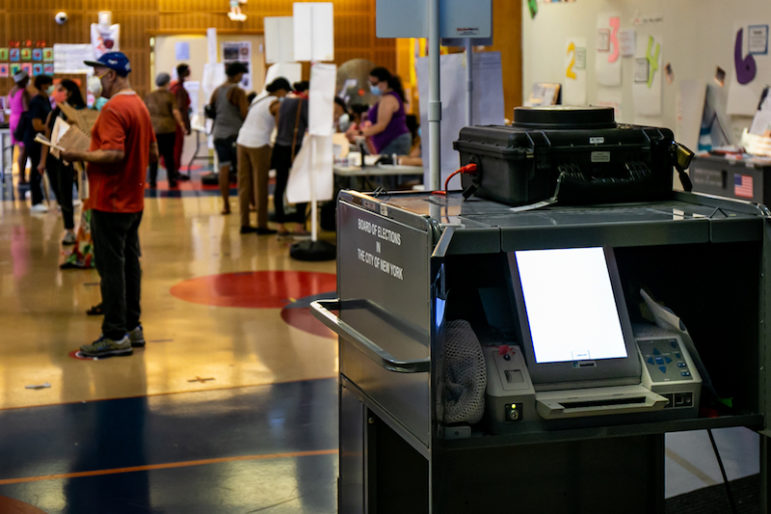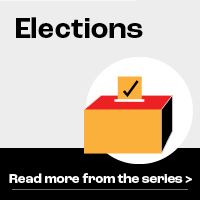
New Yorkers with disabilities had mixed reactions to the accessible absentee ballot option that the state Board of Elections (BOE) implemented for the June 23 primary.
Voters with disabilities named a number of problems with their accessible absentee ballots, from them not being compatible with screen reader technology to having issues with printing the ballot and bringing it to the mailbox independently. These problems, voters with disabilities said, got in the way of them being able to vote independently and privately.
“It was disappointing, in that I was not able to independently mark my ballot without (a sighted person’s) assistance,” said Meghan Parker, a legislative co-chair of the American Council of the Blind New York (ACBNY).
Parker, who is blind, said she wasn’t able to mark the ballot by herself because it was incompatible with her screen-reader technology.
On the other hand, Ian Foley – the other legislative co-chair for ACBNY – said he spoke with members of his organization who had positive experiences with the ballot.
Advocates said the mixed reactions to the BOE’s hastily rolled out accessible absentee ballot means the state agency has taken a step in the right direction but needs to do significantly more to make absentee voting fully accessible, especially amid the COVID-19 pandemic.
“The accessible ballot option that was provided was a step forward but it doesn’t fully resolve the issue,” said Susan Dooha, executive director of the Center for the Independence of the Disabled New York (CIDNY). “So, it’s going to be necessary to pursue a fully accessible ballot for November.”
Following a May 22 lawsuit by a coalition of disability advocacy groups – including ACBNY, CIDNY and Disability Rights Advocates – the BOE agreed to email accessible absentee ballots to voters with disabilities who requested them earlier this month. The most common form of the accessible ballot is a fillable PDF that is supposed to allow voters with disabilities to read and mark the document with assistive technology.
The coalition of advocacy groups filed the lawsuit in response to Gov. Andrew Cuomo’s April executive order that expanded absentee voting amid the coronavirus pandemic. Advocates argue the order violated the Americans with Disabilities Act (ADA) by only allowing for inaccessible paper ballots and not providing an accessible option. They added that the absence of accessible absentee ballots would’ve forced voters to risk their safety by going to the polls to use accessible ballot marking devices during a public health crisis.
Parker, who lives in Albany County, said the ballot she received wasn’t compatible with her screen reader. Specifically, she said, the way it was laid out didn’t allow her to read which delegates corresponded to which presidential candidates. Parker said she thinks the problem with the ballot lies with the vendor who designed it.
“Just because a vendor knows how to create a PDF form and make it accessible doesn’t necessarily mean they’re going to understand how to make a ballot fully accessible and readable to people using screen readers,” Parker said.
Chistina Brandt-Young, a lawyer with Disability Rights Advocates representing some of the plaintiffs in the suit, said the quality of the accessible ballots varied by county across the state, because the state BOE let county BOE’s choose their own vendors for designing the ballots.
“The state Board of Elections gave the county boards of elections a list to choose from,” Brandt-Young said. “And it sounds like some of them did a great job and some of them didn’t do a great job.”
Brandt-Young said that’s why Parker could have a bad experience in Albany County, while voters she spoke with in New York City thought the ballot worked well.
South Bronx resident Jose Hernandez, who’s a quadropoligic and one of the individual plaintiffs in the lawsuit, said he had trouble even getting his ballot in the first place. Hernandez said he went back and forth several times with the BOE before they finally sent him a link to a website with his ballot, which he said is more accessible for him than a fillable PDF. He said because of his disability, the process became inaccessible to him once he had to print the ballot and mail it.
“That’s where my accessibility ended, once it leaves the computer I can’t pull it out of the printer, I can’t fold it and put it into the envelope,” Hernandez said.
This part of the process made voting privately impossible, Herandez said, because he needs his aide to assist him in taking the paper out of the printer, putting it into the envelope and bringing it to the mailbox. Herandez said another problem arose because the ballot didn’t fit onto standard sized 8.5 x 11 inch paper, which he worries may have invalidated his ballot.
“I’m not sure if my vote counted, because I printed it on a regular sized sheet of paper and the ballot was pretty small,” Herandez said. “I don’t know how they’re going to process that, I don’t know how that’s going to get scanned.”
Parker said she would like to see the BOE change its approach to creating accessible absentee ballots for the November election.
“I would like to see one centralized vendor being used for the entire state that has a lot of experience creating ballots,” Parker said.
Hernandez said he’d like the BOE to introduce an option for mailing in the ballot electronically so he won’t have to rely on his aide to help him vote.
“I think for the November 2020 elections, I think the Board of elections [should] make it so that I can submit (the ballot) electronically,” Hernandez said. “So, some way that I can be confident that my vote’s going to count, especially this year given the magnitude of the November election.”










One thought on “New York’s New Accessible Absentee Ballots Aren’t Accessible Enough, Voters Say”
And there’s that crazy expectation that you have to print something regular paper and fold it into a useful envelope. Who can do that?